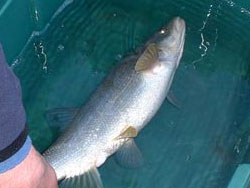
|
Anglers Took Part in Northern Pikeminnow Tagging
On January 27th, members of the Fraser Valley Salmon Society (FVSS) assisted DFO in tagging northern pikeminnows in Cultus Lake. This work is part of an ongoing project that studies the relationship between endangered Cultus Lake sockeye and northern pikeminnows. Until now, our knowledge of the life history of Cultus Lake northern pikeminnows has been limited to the spring and summer months; for example we knew that they stage in large schools in deeper water in late springs, then spawn en masse very close to shore. Earlier tagging studies, in which northern pikeminnows were floy tagged during the summer months, showed that they did not stray far from where they were originally tagged and there are even indications of discreet spawning populations throughout the lake. DFO anglers were able to catch and tag 3 northern pikeminnows during November but that number was too small to gather meaningful data. The purpose of this outing was to catch and tag more northern pikeminnows so we could monitor their movements during winter. Many thanks to Frank Kwak for rounding up the members, Nick Basok and Dean Werk for their boats and guiding skills, and to George, Chris, Gwyn, Jackie, Don, Gary, Frank and Grant for their angling prowess. Despite the frosty weather and 5.0°C water, these anglers were able to catch six northern pikeminnows. Fishing was tough due to the cold water but eventually the fish were found about 100 m offshore in 25m of water. They all measured over the required 275mm necessary for tagging, including a slab (44 cm) caught by local Maple Leaf fan and regular FWR contributor, Chris Gadsden. Top rod was George Noordegraaf who boated a pair of the shimmering beauties. As soon as a fish was caught it was floy tagged, identified with it's own unique number, and the catch location was documented with GPS. Fish were then transported to shore where DFO biologist Christine Tovey went to work. Fish were anesthetised and when completely immobile an acoustic tag was surgically implanted. When fully recovered the fish were transported back and released at the precise location they were caught. These tags will send out information on the whereabouts and depth of the fish for about 480 days. Weekly surveys will be conducted on the lake to track these fish and will soon be available for all to see on our Cultus Sockeye Recovery website. To see more photos of Saturday's tagging study, please visit this photo album. Related readings:
|
|||||||||||||
| Advertisements |
| Berry's Bait & Tackle Serving the fishing industry for over 33 years, we carry the largest selection of fresh and saltwater fishing tackle in BC. 1,000 of items available in our E-store. Visit us at www.berrysbait.com! |
| Reaction Fly & Tackle Featuring everything you need from the beginner to the pro. Great selection of flies, drift, spin, tying materials, waders, boots, outdoor apparel & rod building supplies. Phone 604-870-FLY1(3591) or visit www.reactionbaits.com |
| Does your reel need a service? Stryker Rod & Reel in Surrey is an Authorized Warranty / Service Center for Abu Garcia, Mitchell, Fenwick, Johnson and Spidercast fishing reels in Canada. Visit Stryker Rod & Reel and contact Russ Goodwin at 604-585-6958. |
| Ultimate Fishing Trip! Book now and receive 10% off on Ultimate sturgeon and salmon trips before March 31st. Contact Randy Beck at 604-945-3006 or visit Ultimate Sportfishing! |


